Regen Melbourne has created an innovative framework to bring civic and natural life to the city.
Author: Alison Whitten
It was mid-2020 and the streets of Melbourne were eerily quiet. At the start of the year, Melburnians had scurried inside, closing up doors and windows to avoid the effects of bushfire smoke that settled on the city. Before long, this voluntary seclusion morphed into government-imposed COVID-19 lockdowns, also designed to protect human health. These lockdowns eventually became known as some of the longest and strictest in the world.
Melbourne is known for its liveability and has long attracted visitors and new residents alike for this reason. But, this period of acute crisis laid bare some truths about the city. First, the Black Summer bushfires made our region’s vulnerability to the impacts of climate change obvious. Then, as the lockdowns quickly disrupted our basic social and economic structures, it became starkly clear that the city’s liveability is not equally available to everyone.
At this time, as cities all over the world were thinking about how to facilitate a sustainable economic recovery from COVID-19, a group of community, philanthropic and local council organisations in Melbourne began to discuss what it would look like to apply Doughnut Economics to develop a new vision for the city. With a small amount of seed funding, this cohort ran a community-led research project to explore how the Doughnut model - which describes a ‘safe and just space’ where human needs are met within ecological limits - could be scaled to Greater Melbourne.
The response was affirming and exciting: over 500 people and 50 organisations contributed to the project through a series of workshops, roundtables and targeted interviews. The resulting report, Towards a Regenerative Melbourne, articulated an aspirational vision for the city’s future and a number of initial steps to move towards it.
The momentum from this work and the potential that it inspired enabled a second round of funding, this time enough for Regen Melbourne to establish its purpose and build a small team. Over the past four years, we have experimented, evolved and affirmed our role as an engine for collaboration in service to the regeneration of Greater Melbourne. We talk about this work as ‘transitional infrastructure’, creating the scaffolding to enable long-term change in our city.
This now includes three key elements that form the basis of our strategy:
While it was created at a particular point in time, the Collective Vision that emerged from the initial community-led research project continues to define Regen Melbourne’s purpose and long-term ambition for the city. The Vision names what it is we are working towards in Greater Melbourne by describing what a Regenerative Melbourne means.
A Regenerative Melbourne is:
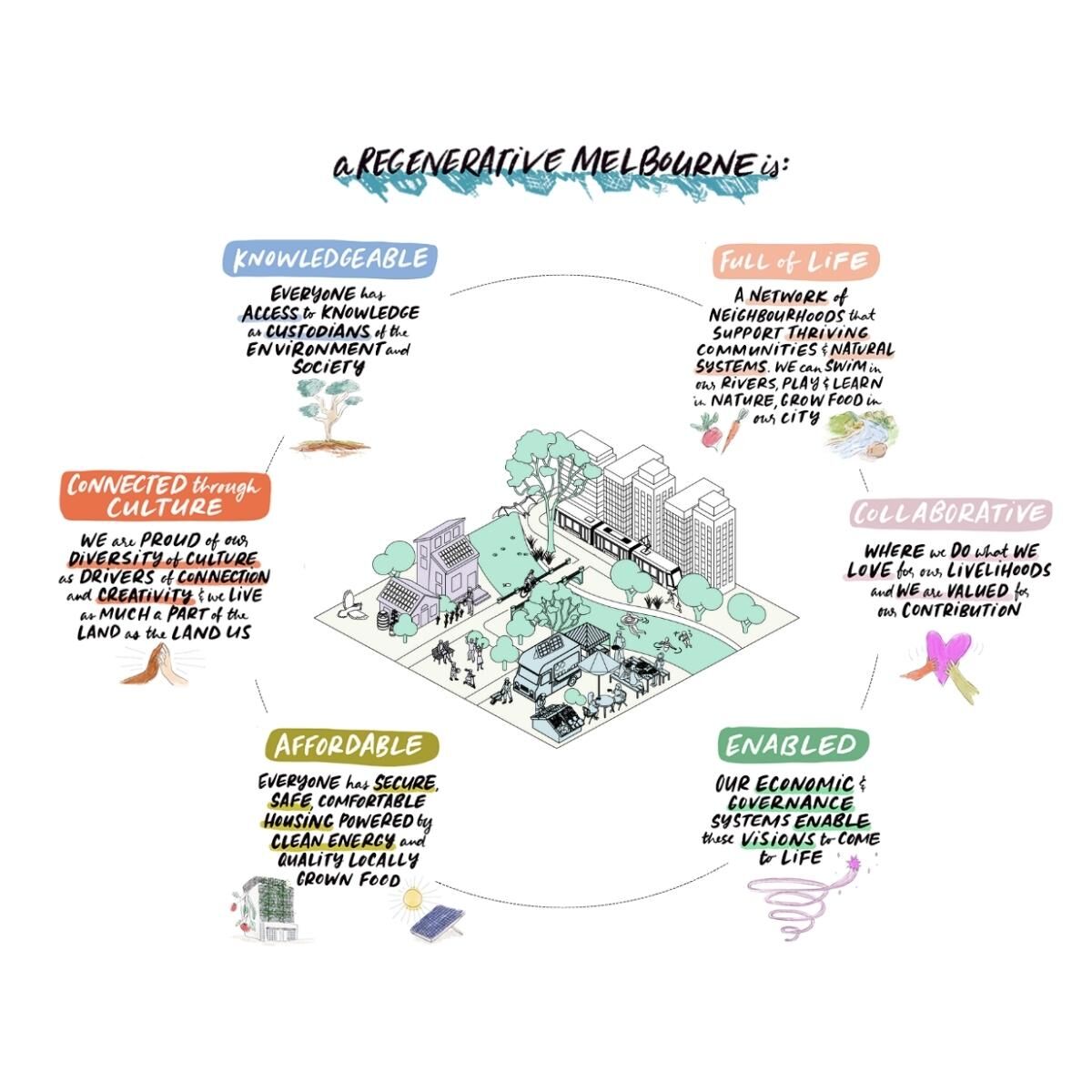
The Vision sits alongside the Melbourne Doughnut, an illustrated version of the Doughnut Economics framework. The Melbourne Doughnut serves as a compass for directing us towards a regenerative future in Greater Melbourne where the needs of people and planet are kept in balance. It is a localised interpretation of the Doughnut, with Melbourne-oriented elements added (eg Arts & Culture as part of the Social Foundation, the ‘Reconnecting to Country and Each Other’ dynamic ring). This qualitative model provided a foundation for developing more measurable goals for Greater Melbourne through the Greater Melbourne City Portrait, a model that sets quantifiable social and ecological targets for a place.
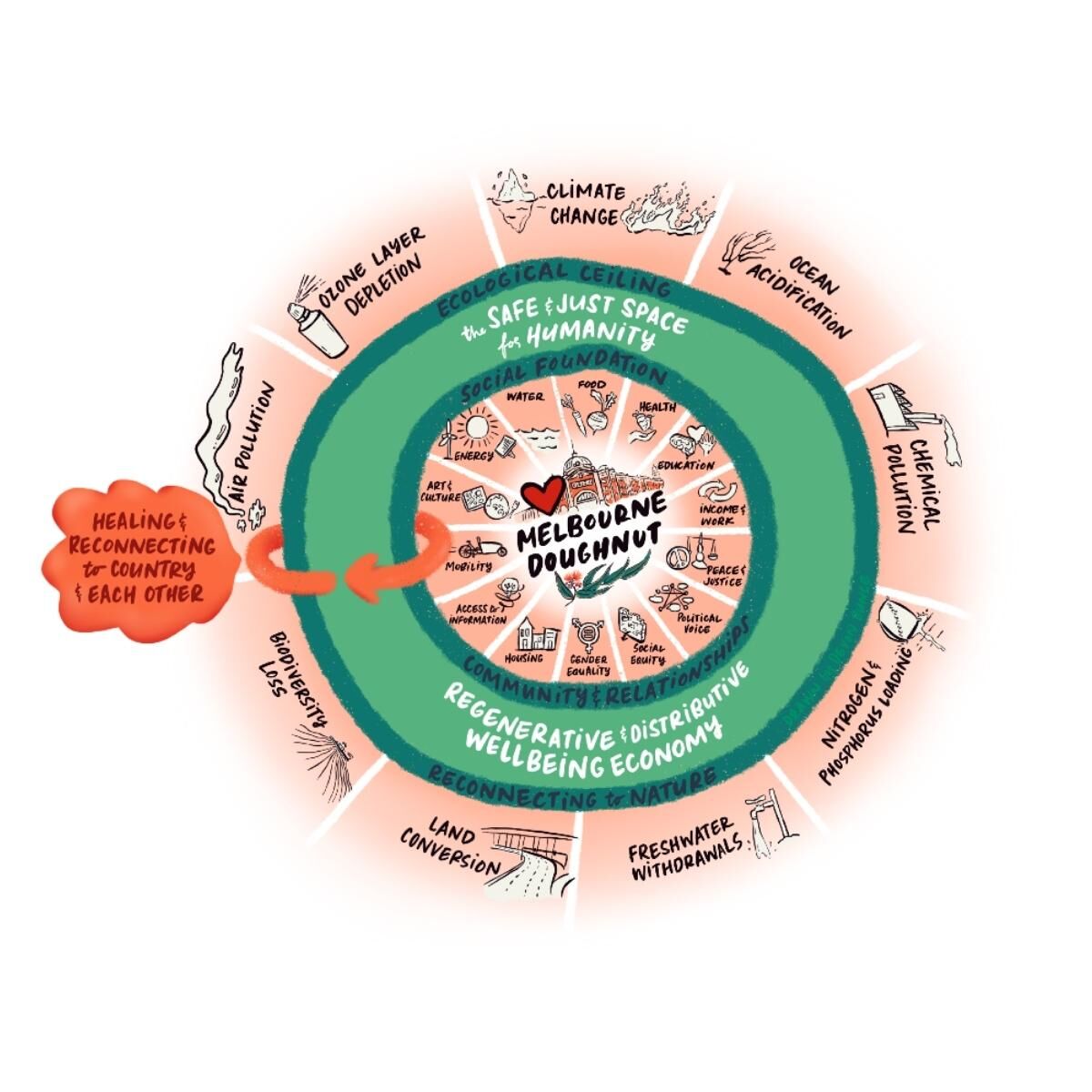
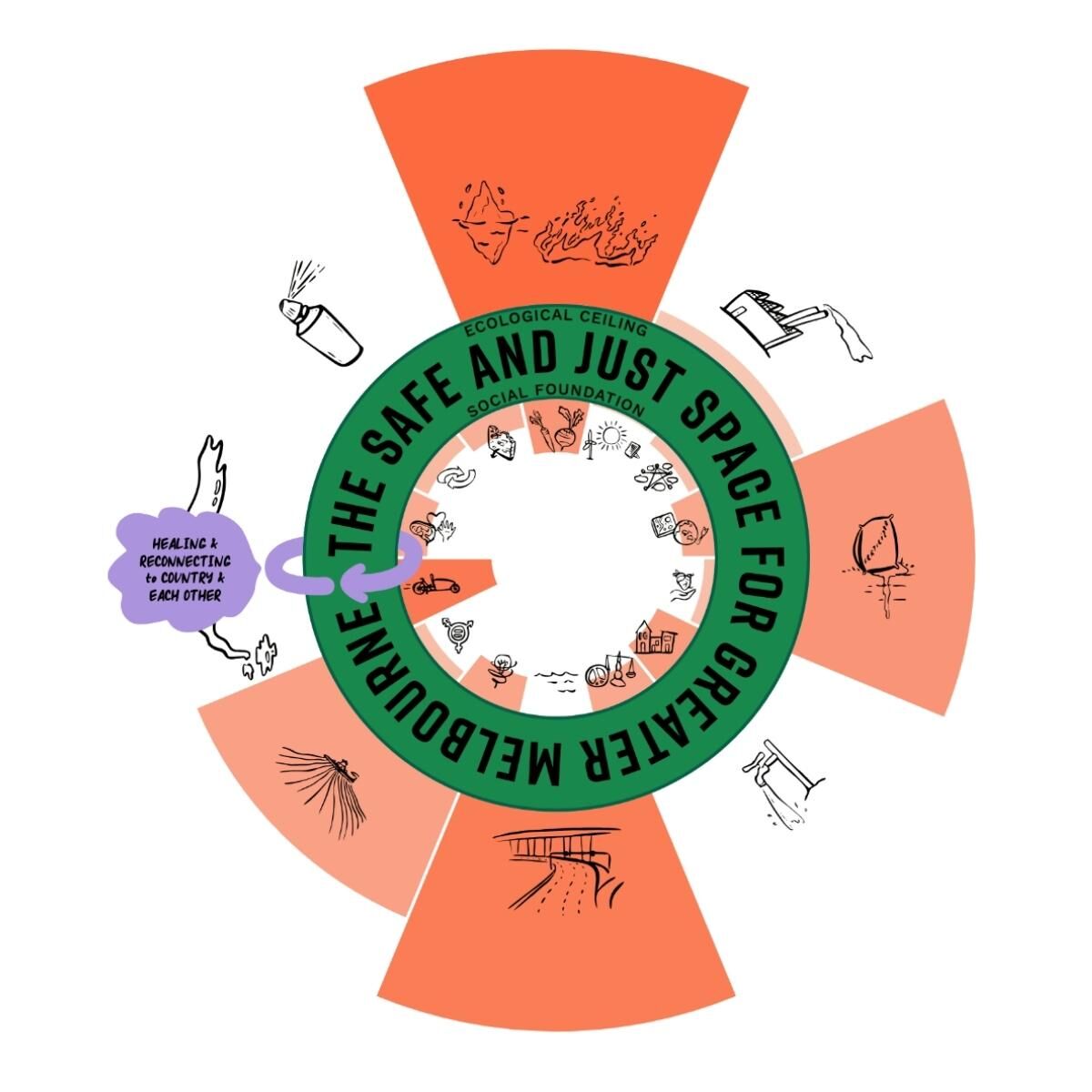
The collective aspect of the Vision and the Melbourne Doughnut has been foundational to Regen Melbourne’s mandate and social license since its inception. The Vision continues to invite a collaborative response to the city’s pressing social and ecological challenges, pointing to what is possible when we adopt new ways of working together.
In our early days, we experimented with grassroots organising and activation. Through this initial phase, it became apparent to us that this was a very full and busy space: there was plenty of grass already growing, alongside trees, shrubs and other forms of more established activity. What was needed was curation and coordination to bring these elements together in a more coherent form, helping them to achieve their potential in service of regeneration.
We first identified this need in relation to the Birrarung (Yarra River), the central river in Melbourne. A range of actors had been advocating on behalf of the river for years, under banners ranging from ecological health to cultural significance to economic value. A coherent approach to river regeneration was needed - and from this, the Swimmable Birrarung became Regen Melbourne’s first ‘Earthshot’.
Now, we describe Earthshots as declarations of intent to solve complex social and ecological challenges. They are the transformations we organise our work around, acting as pathways towards the Collective Vision and Melbourne Doughnut, and require ambition of possibility, coherence of a collective response and agitation of the current system.
As a portfolio, we work across three layers of the city: waterways, food and streets. The history of our place is held in these layers, the culture of our place comes alive here and the intersection between the three is where we can see the highest potential for radical transformation.
The Earthshots are:
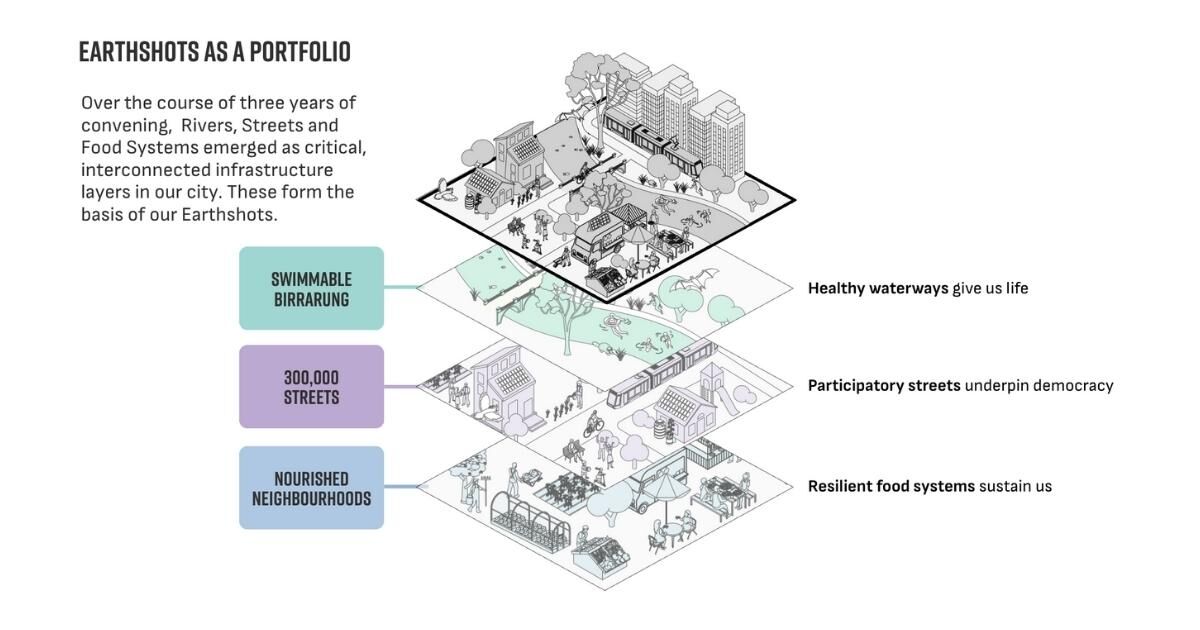
Each of the Earthshots began with a relational sensemaking phase to understand the current system and its needs. As the Earthshots have evolved, each has developed an ‘architecture’ that captures its high-level goal and the transition pathways underpinning it, as well as the types of actors involved in the work. This not only allows us to build coherence within each Earthshot, but also across the portfolio.
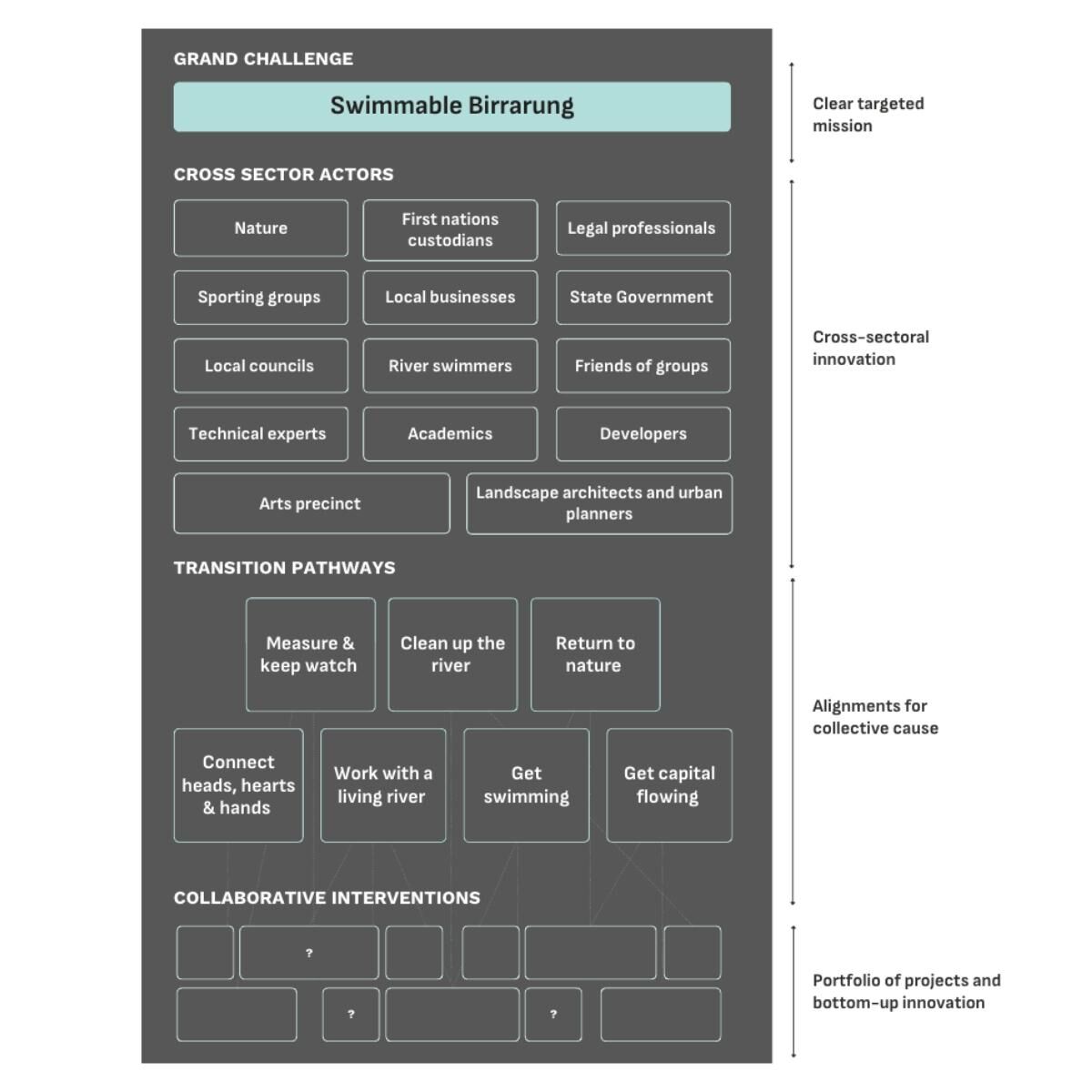
Sitting alongside the Earthshots, the Systems Lab (the Lab) is an action-research platform that explores how to shift conditions in our systems to facilitate place-based change. The work of the Lab starts with an understanding that our current systems present barriers to progressing towards a more regenerative economic future, in Greater Melbourne and beyond. These include (but are not limited to) shortcomings in the ways that decision-making occurs (who decides, and based on what objectives), how capital flows (who controls it, and for what ends) and how knowledge is generated and applied. The Lab started with a focus on embedding research into Regen Melbourne’s work, but has broadened to include a set of enablers identified as necessary through the Earthshots as they have taken shape.
The enablers currently explored through the Systems Lab include:
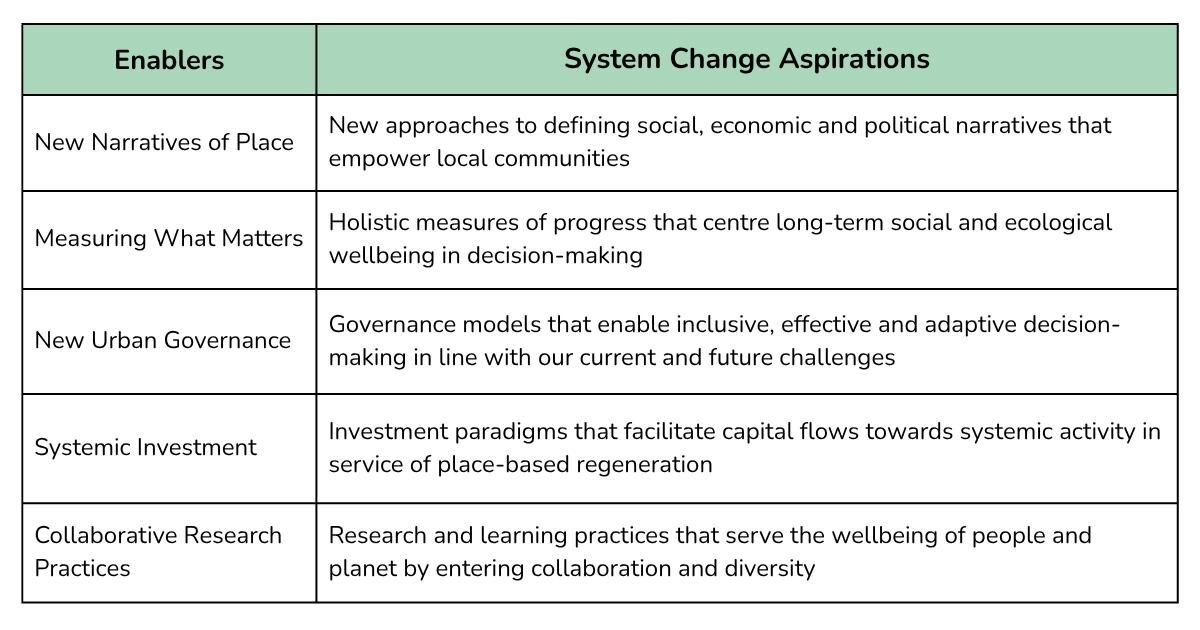
The Lab instigates, hosts and coordinates collaborative experiments. These experiments test new approaches, models, tools and interventions that facilitate new ways of working in relation to each of the enablers. These experiments build knowledge about the effectiveness of the interventions and their potential to unlock deeper change that can accelerate place-based initiatives. As such, the work on each of the enablers is designed as an action-research stream, in which we:
Increasingly, we have seen an appetite for sharing learning across place-based initiatives and collaborators in Australia and globally.
While each of these elements, the Collective Vision, Earthshots and Systems Lab, carries value on its own, the real strength comes from the scaffolding created when we bring them together. Our regeneration journey is a generational one, and having the right infrastructure to support our efforts is important.
We welcome conversations about the shape of Regen Melbourne’s work, as outlined here, and will continue to share what we are learning as the work on the ground progresses.
Discover more at: https://www.regen.melbourne and please reach out to alison@regen.melbourne to learn more and connect.
The publisher is Citizen Network. Regen Melbourne: collaborative infrastructure for urban transformation © Alison Whitten 2025.
community, Neighbourhood Care, Neighbourhood Democracy, Sustainability, Australia, Europe, Global, Article